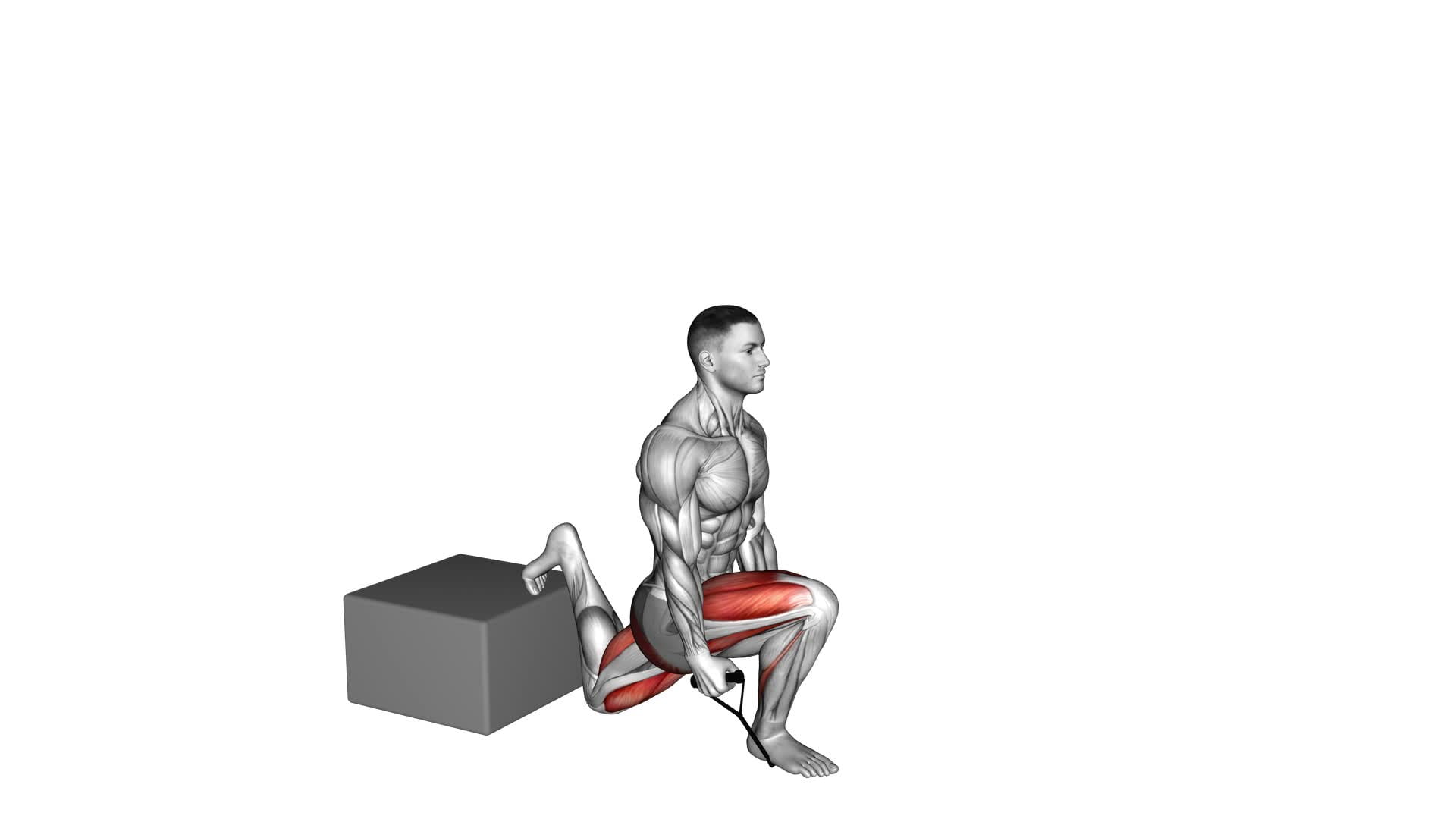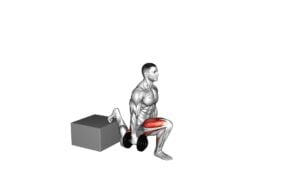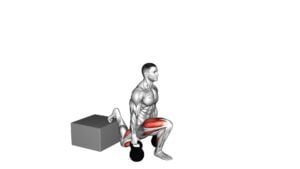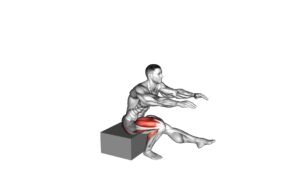Band Single Leg Split Squat With Low Box – Video Exercise Guide & Tips

Are you looking for a challenging lower body exercise that targets your quads, glutes, and hamstrings? Look no further than the Band Single Leg Split Squat with Low Box.
Watch This Exercise Video
In this video exercise guide, you'll learn the proper form and technique, as well as modifications and progressions to make it more or less challenging.
Avoid common mistakes and get the most out of your workout with these helpful tips.
Let's get started!
Key Takeaways
- The band single leg split squat targets multiple muscle groups including the quads, glutes, and hamstrings.
- This exercise improves lower body strength, stability, balance, and joint support.
- Using resistance bands increases muscle activation and adds intensity to the exercise.
- Proper form and technique, as well as gradual progression, are important for maximizing the benefits of this exercise.
Benefits of the Band Single Leg Split Squat
You can experience significant improvements in lower body strength and stability by incorporating the Band Single Leg Split Squat into your workout routine. This exercise targets multiple muscle groups, including the quadriceps, hamstrings, glutes, and calves. By using a resistance band, you can add an extra challenge to the movement and increase muscle activation.
One of the benefits of the Band Single Leg Split Squat is that it helps to improve balance and stability. This exercise requires you to maintain your balance on one leg while performing the squatting motion. This can help to strengthen the muscles that support your joints and improve overall stability.
However, it's important to take precautions when performing this exercise. Make sure to choose a resistance band that provides enough tension without causing pain or discomfort. Also, be mindful of your form and avoid leaning too far forward or allowing your knee to collapse inward. Keep your chest up and engage your core to maintain proper alignment.
In terms of muscle activation, the Band Single Leg Split Squat primarily targets the quadriceps, which are the muscles on the front of your thigh. It also engages the hamstrings, glutes, and calves to a lesser extent. By incorporating this exercise into your routine, you can build strength and increase muscle tone in these areas.
Equipment Needed for the Exercise
To perform the Band Single Leg Split Squat with Low Box exercise, you'll need a few pieces of equipment. Here are the types of equipment you'll need and the advantages they provide:
- Resistance bands: These are elastic bands that provide resistance during the exercise. They help to increase the intensity of the movement and target the muscles in your legs and glutes more effectively.
- Low box: A low box or step is used to elevate your back foot during the exercise. It helps to increase the range of motion and activate the muscles in your front leg.
- Dumbbells: Although not necessary, holding dumbbells in each hand can add an extra challenge to the exercise. They increase the load on your muscles, making them work harder and promoting muscle growth.
- Exercise mat: An exercise mat provides cushioning and support for your knees and hands. It also helps to prevent any discomfort or pain during the exercise.
Using these equipment types has several advantages. Resistance bands allow you to easily adjust the intensity of the exercise, making it suitable for individuals of different fitness levels. The low box helps to improve balance, stability, and coordination. Dumbbells add an extra challenge and can enhance strength gains. Lastly, the exercise mat provides comfort and protects your joints from excessive pressure.
Proper Form and Technique
The proper form and technique for performing the Band Single Leg Split Squat with Low Box exercise is essential for maximizing the benefits and minimizing the risk of injury. To begin, place a low box behind you and position one foot on top of it. The other foot should be placed in front of you, with the heel lifted off the ground. Hold the handles of a resistance band, with your arms extended in front of you.
As you lower your body into the squat position, ensure that your front knee stays in line with your toes and doesn't go past them. Keep your torso upright and engage your core muscles for stability. It's important to maintain a neutral spine throughout the movement.
As you push through your front heel to return to the starting position, focus on activating your glutes and quads. The resistance band adds an additional challenge by increasing muscle activation. By performing this exercise with proper form and technique, you can improve stability and target the muscles of your lower body effectively.
Remember to start with a lighter resistance band and gradually increase the tension as you become more comfortable with the exercise. Always listen to your body and stop if you experience any pain or discomfort.
Modifications and Progressions
To make the Band Single Leg Split Squat with Low Box exercise more challenging, you can incorporate modifications and progressions. Here are some alternative exercises and advanced variations to help you take your workout to the next level:
- Bulgarian Split Squats: Instead of using a band, you can perform the split squat with your back foot elevated on a bench or step. This increases the range of motion and targets your glutes and hamstrings even more.
- Single Leg Squats: If you're looking for a more advanced variation, try performing the split squat without any assistance from the back foot. This requires greater stability and strength in your working leg.
- Weighted Split Squats: To further increase the intensity, you can hold a dumbbell or kettlebell in each hand during the exercise. This adds resistance and helps to build muscle and strength.
- Plyometric Split Squats: For those who are looking to add explosive power to their lower body, try incorporating plyometric movements into the split squat. Perform a jump between each rep, switching legs mid-air. This challenges your muscles in a different way and improves your athletic performance.
Remember to always prioritize proper form and technique before attempting advanced variations. Gradually progress as you build strength and stability.
Common Mistakes to Avoid
One common mistake to avoid when performing the Band Single Leg Split Squat with Low Box exercise is neglecting proper alignment and balance. It's crucial to maintain proper form throughout the exercise to avoid injury and maximize the benefits of the exercise.
When performing this exercise, ensure that your front knee is directly over your ankle, forming a 90-degree angle. Avoid letting your knee extend beyond your toes, as this can put excessive stress on the knee joint. Additionally, make sure that your back knee is slightly above the ground, with your weight evenly distributed between both legs. This will help improve balance and stability.
Another common mistake to avoid isn't using a low enough box. Using a box that's too high can compromise your form and increase the risk of injury. Start with a lower box and gradually work your way up as you build strength and stability.
Tips for Getting the Most Out of Your Workout
Maximize your workout by prioritizing consistency and intensity. To get the most out of your workout and improve efficiency, follow these tips:
- Set specific goals: Define what you want to achieve from your workout. Whether it's building strength, improving endurance, or losing weight, having clear goals will help you stay focused and motivated.
- Plan your workouts: Create a structured workout plan that includes a variety of exercises targeting different muscle groups. This will ensure that you're maximizing your results and preventing boredom.
- Challenge yourself: Pushing your limits is key to improving workout efficiency. Gradually increase the intensity of your exercises by adding more weight, increasing repetitions, or reducing rest time between sets.
- Listen to your body: Pay attention to how your body feels during and after your workouts. If you're experiencing pain or discomfort, adjust your exercises or seek guidance from a fitness professional. It's important to find a balance between pushing yourself and avoiding injury.
Frequently Asked Questions
How Many Repetitions Should I Do for the Band Single Leg Split Squat?
For the band single leg split squat, start by focusing on the number of repetitions. It's important to find a balance between challenging yourself and maintaining proper form. Start with a manageable number, such as 8 to 10 repetitions per leg, and gradually increase as you get stronger.
Remember, quality over quantity is key.
As for variations, there are many options to explore, including adding weights, using different bands for resistance, or incorporating a low box for added stability and range of motion.
Can I Perform the Band Single Leg Split Squat Without Using a Resistance Band?
Yes, you can perform the band single leg split squat without using a resistance band.
However, using a resistance band offers several benefits such as adding extra resistance to your workout and targeting specific muscles.
If you don't have a resistance band, you can try alternative exercises like weighted split squats or Bulgarian split squats.
These exercises still work your legs and glutes effectively, but without the added resistance from the band.
Is the Band Single Leg Split Squat Suitable for Beginners?
Yes, the band single leg split squat is suitable for beginners. It's a great exercise for building leg strength and stability. If you're new to this exercise, you can modify it by using a lower resistance band or no band at all.
However, incorporating band resistance can provide additional benefits, such as increasing muscle activation and adding a challenge to the exercise.
Can the Band Single Leg Split Squat Help Improve My Balance?
Improving balance is a key benefit of the band single leg split squat. By engaging your core and stabilizer muscles, this exercise helps you develop better balance and control.
To perform it properly, maintain proper form with your back straight, chest up, and knee in line with your toes.
As you progress, you can increase the difficulty by using a higher box or adding more resistance with the band.
Are There Any Specific Muscles That the Band Single Leg Split Squat Targets?
The band single leg split squat targets several specific muscles in your lower body. It primarily works your quadriceps, hamstrings, glutes, and calf muscles. This exercise is great for building strength and stability, as well as improving your balance.
Conclusion
Incorporating the band single leg split squat with a low box into your workout routine can provide numerous benefits, including improved lower body strength, stability, and balance.
It's a challenging exercise that requires proper form and technique to avoid common mistakes.
By following the tips and modifications provided, you can maximize the effectiveness of this exercise and get the most out of your workout.

Author
Years ago, the spark of my life’s passion ignited in my mind the moment I stepped into the local gym for the first time. The inaugural bead of perspiration, the initial endeavor, the very first surge of endorphins, and a sense of pride that washed over me post-workout marked the beginning of my deep-seated interest in strength sports, fitness, and sports nutrition. This very curiosity blossomed rapidly into a profound fascination, propelling me to earn a Master’s degree in Physical Education from the Academy of Physical Education in Krakow, followed by a Sports Manager diploma from the Jagiellonian University. My journey of growth led me to gain more specialized qualifications, such as being a certified personal trainer with a focus on sports dietetics, a lifeguard, and an instructor for wellness and corrective gymnastics. Theoretical knowledge paired seamlessly with practical experience, reinforcing my belief that the transformation of individuals under my guidance was also a reflection of my personal growth. This belief holds true even today. Each day, I strive to push the boundaries and explore new realms. These realms gently elevate me to greater heights. The unique combination of passion for my field and the continuous quest for growth fuels my drive to break new ground.







